-
 Bitcoin
Bitcoin $106,754.6083
1.33% -
 Ethereum
Ethereum $2,625.8249
3.80% -
 Tether USDt
Tether USDt $1.0001
-0.03% -
 XRP
XRP $2.1891
1.67% -
 BNB
BNB $654.5220
0.66% -
 Solana
Solana $156.9428
7.28% -
 USDC
USDC $0.9998
0.00% -
 Dogecoin
Dogecoin $0.1780
1.14% -
 TRON
TRON $0.2706
-0.16% -
 Cardano
Cardano $0.6470
2.77% -
 Hyperliquid
Hyperliquid $44.6467
10.24% -
 Sui
Sui $3.1128
3.86% -
 Bitcoin Cash
Bitcoin Cash $455.7646
3.00% -
 Chainlink
Chainlink $13.6858
4.08% -
 UNUS SED LEO
UNUS SED LEO $9.2682
0.21% -
 Avalanche
Avalanche $19.7433
3.79% -
 Stellar
Stellar $0.2616
1.64% -
 Toncoin
Toncoin $3.0222
2.19% -
 Shiba Inu
Shiba Inu $0.0...01220
1.49% -
 Hedera
Hedera $0.1580
2.75% -
 Litecoin
Litecoin $87.4964
2.29% -
 Polkadot
Polkadot $3.8958
3.05% -
 Ethena USDe
Ethena USDe $1.0000
-0.04% -
 Monero
Monero $317.2263
0.26% -
 Bitget Token
Bitget Token $4.5985
1.68% -
 Dai
Dai $0.9999
0.00% -
 Pepe
Pepe $0.0...01140
2.44% -
 Uniswap
Uniswap $7.6065
5.29% -
 Pi
Pi $0.6042
-2.00% -
 Aave
Aave $289.6343
6.02%
Is the shrinking cross star a signal of a change in the market? How to operate?
The shrinking cross star in crypto trading signals potential trend reversals when a large candle is followed by a small-bodied cross-shaped candle, indicating fading momentum and possible consolidation.
Jun 17, 2025 at 11:01 am
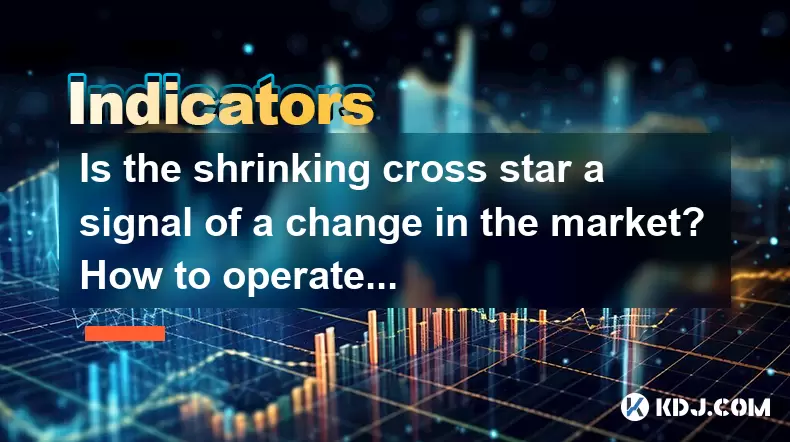
What Is a Shrinking Cross Star Pattern?
The shrinking cross star is a candlestick pattern often observed in cryptocurrency trading charts. It typically appears after a significant price movement and consists of a large real body candle followed by a smaller candle with long upper and lower shadows, forming a cross-like shape. The key feature of the shrinking cross star is that its real body becomes significantly smaller than the previous candle, indicating waning momentum.
In the context of cryptocurrency markets, where volatility is high, this pattern can suggest a potential reversal or consolidation phase. Traders should closely monitor volume during the formation of this pattern, as it may provide additional confirmation of a possible trend change.
Important Note:
This pattern alone should not be used to make trading decisions without confirming signals from other indicators or tools.How Does the Shrinking Cross Star Appear on Charts?
To identify the shrinking cross star on a chart:
- Look for a strong bullish or bearish candle preceding the pattern.
- Observe the next candle having a very small real body, regardless of whether it's bullish or bearish.
- Check if the shadows (wicks) are notably longer than the body, resembling a cross or doji.
This formation usually indicates indecision among traders. In crypto markets, where sentiment plays a crucial role, such patterns often appear before major price swings. For example, after a sharp rise in Bitcoin or Ethereum prices, a shrinking cross star might signal that buyers are losing control.
- Candle 1: A strong directional candle showing clear dominance by either bulls or bears.
- Candle 2: A cross-shaped candle with minimal body, suggesting hesitation in price direction.
- Volume Check: Compare the volume of both candles — a drop in volume supports the idea of weakening momentum.
Why Is Volume Important When Confirming This Pattern?
Volume serves as a critical component when analyzing the validity of the shrinking cross star. If the second candle forms with low volume compared to the first, it reinforces the idea that the prior trend is losing strength.
For instance, during a bullish run in altcoins like Solana or Cardano, a sudden appearance of a shrinking cross star accompanied by declining volume could indicate that buying pressure is fading. Conversely, if volume remains high, the pattern may be less reliable as a reversal signal.
- High Volume: May suggest continued interest despite the cross star formation.
- Low Volume: Often confirms a loss of momentum and increases the likelihood of a reversal.
- Volume Tools: Use platforms like TradingView or Binance’s native chart tools to overlay volume data beneath price charts.
How to Trade Based on the Shrinking Cross Star Signal?
Trading based on this pattern requires caution and proper risk management. Here’s how to approach it:
- Identify the Pattern: Ensure the shrinking cross star appears after a clear trend.
- Wait for Confirmation: Do not act immediately after the cross star forms. Wait for the next candle to confirm the direction.
- Set Entry Points: If the following candle breaks below the low of the cross star in an uptrend, consider entering a short position.
- Place Stop Losses: Always place stop losses above the high of the cross star to limit downside risk.
- Use Take Profit Levels: Calculate support and resistance levels to determine profit targets.
- Entry Strategy: Wait for a breakout candle after the cross star to enter the market.
- Stop Loss Placement: Set stops just beyond the highest point of the cross star.
- Risk-Reward Ratio: Aim for at least 1:2 ratio between your stop loss and take profit.
Which Indicators Work Best with the Shrinking Cross Star?
While the shrinking cross star is a powerful visual signal, combining it with technical indicators enhances accuracy. Some of the most effective ones include:
- Relative Strength Index (RSI): Helps determine overbought or oversold conditions around the time the pattern forms.
- Moving Averages: Can help assess the strength of the current trend.
- MACD (Moving Average Convergence Divergence): Useful for identifying changes in momentum.
- RSI Integration: If RSI is near 70 or above, and a cross star appears, it strengthens the reversal signal.
- MACD Confirmation: A bearish MACD crossover after the cross star adds weight to a sell setup.
- Moving Averages: Watch for price crossing below key moving averages like the 50-period MA.
Frequently Asked Questions
Q: Can the shrinking cross star appear on all timeframes?
Yes, it can form on any timeframe including 1-minute, 4-hour, daily, or weekly charts. However, higher timeframes like 4-hour or daily offer more reliable signals due to reduced noise and increased participation from institutional traders.
Q: What is the difference between a shrinking cross star and a doji?
A shrinking cross star specifically follows a large candle and shows a reduction in body size, while a doji simply represents market indecision without necessarily indicating a trend change. The context matters more for the cross star.
Q: Should I trade every occurrence of the shrinking cross star?
No, only trade when the pattern aligns with other technical signals like volume decline, RSI divergence, or moving average crossovers. Blindly trading every cross star may lead to losses due to false signals.
Q: How common is the shrinking cross star in cryptocurrency trading?
It occurs frequently in crypto due to high volatility and rapid price swings. Traders must filter out weak signals by combining it with other analytical tools to improve accuracy.
Disclaimer:info@kdj.com
The information provided is not trading advice. kdj.com does not assume any responsibility for any investments made based on the information provided in this article. Cryptocurrencies are highly volatile and it is highly recommended that you invest with caution after thorough research!
If you believe that the content used on this website infringes your copyright, please contact us immediately (info@kdj.com) and we will delete it promptly.
- 2025-W Uncirculated American Gold Eagle and Dr. Vera Rubin Quarter Mark New Products
- 2025-06-13 06:25:13
- Ruvi AI (RVU) Leverages Blockchain and Artificial Intelligence to Disrupt Marketing, Entertainment, and Finance
- 2025-06-13 07:05:12
- H100 Group AB Raises 101 Million SEK (Approximately $10.6 Million) to Bolster Bitcoin Reserves
- 2025-06-13 06:25:13
- Galaxy Digital CEO Mike Novogratz Says Bitcoin Will Replace Gold and Go to $1,000,000
- 2025-06-13 06:45:13
- Trust Wallet Token (TWT) Price Drops 5.7% as RWA Integration Plans Ignite Excitement
- 2025-06-13 06:45:13
- Ethereum (ETH) Is in the Second Phase of a Three-Stage Market Cycle
- 2025-06-13 07:25:13
Related knowledge
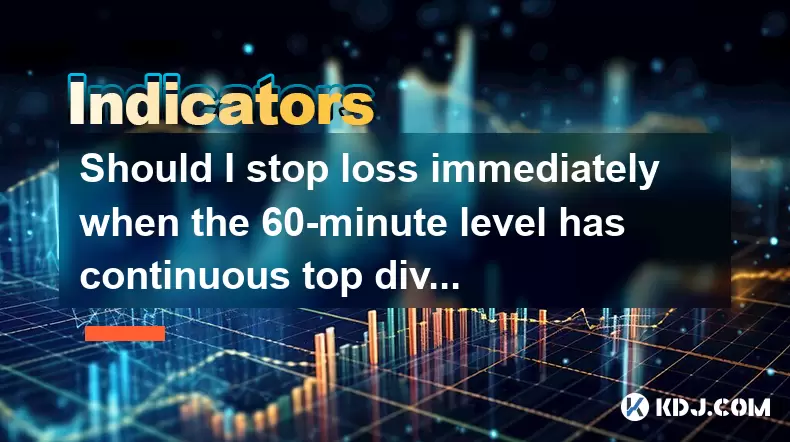
Should I stop loss immediately when the 60-minute level has continuous top divergence?
Jun 17,2025 at 05:28pm
Understanding Top Divergence in the 60-Minute ChartIn cryptocurrency trading, top divergence refers to a technical signal where the price of an asset makes higher highs while the indicator (often RSI or MACD) makes lower lows. This is commonly interpreted as a sign of weakening momentum and potential reversal. When this occurs on the 60-minute chart, it...
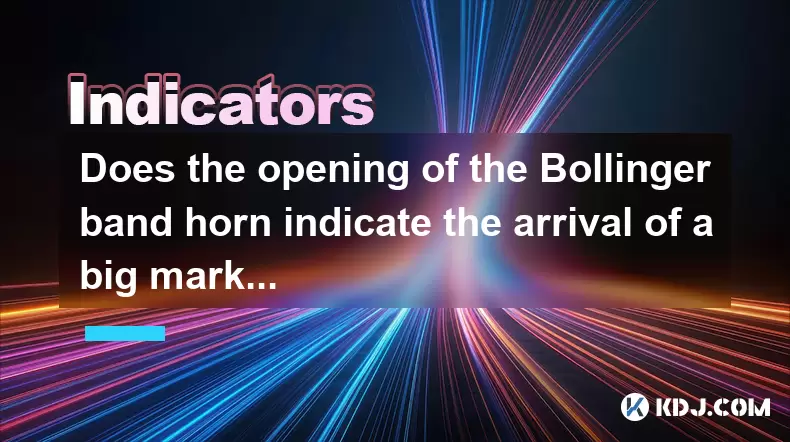
Does the opening of the Bollinger band horn indicate the arrival of a big market?
Jun 17,2025 at 06:28pm
Understanding the Bollinger Bands and Their StructureBollinger Bands are a widely used technical analysis tool in the cryptocurrency market, developed by John Bollinger. They consist of three lines: a simple moving average (SMA), typically set at 20 periods, and two standard deviation bands above and below this SMA. These bands dynamically expand and co...
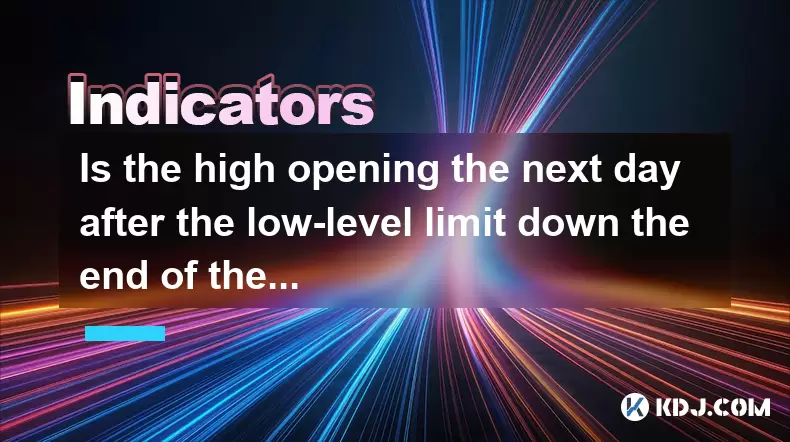
Is the high opening the next day after the low-level limit down the end of the wash?
Jun 17,2025 at 05:57pm
Understanding the Concept of a Limit Down and Its ImplicationsIn the world of cryptocurrency trading, a limit down refers to a situation where the price of a digital asset drops sharply, reaching its maximum allowable decline within a specific time frame. This mechanism is often seen on exchanges that implement daily price limits to prevent excessive vo...
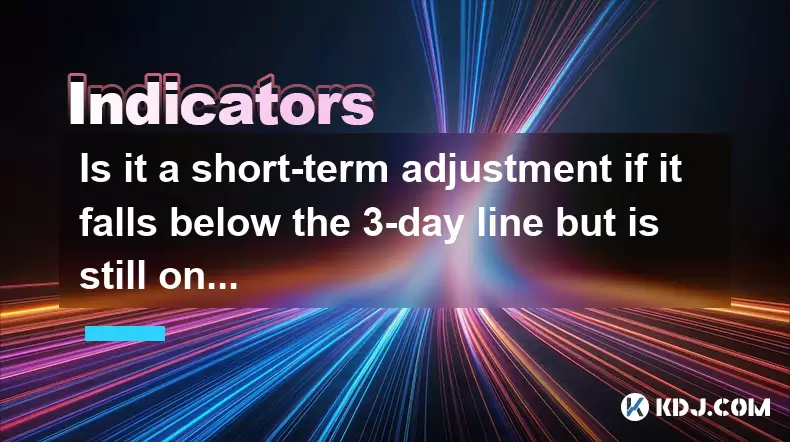
Is it a short-term adjustment if it falls below the 3-day line but is still on the 10-day line?
Jun 17,2025 at 04:07pm
Understanding the 3-Day and 10-Day Moving AveragesIn cryptocurrency trading, moving averages are essential tools for gauging trend strength and potential reversals. The 3-day moving average is a short-term indicator that reflects recent price action with minimal lag, making it highly sensitive to sudden market shifts. In contrast, the 10-day moving aver...
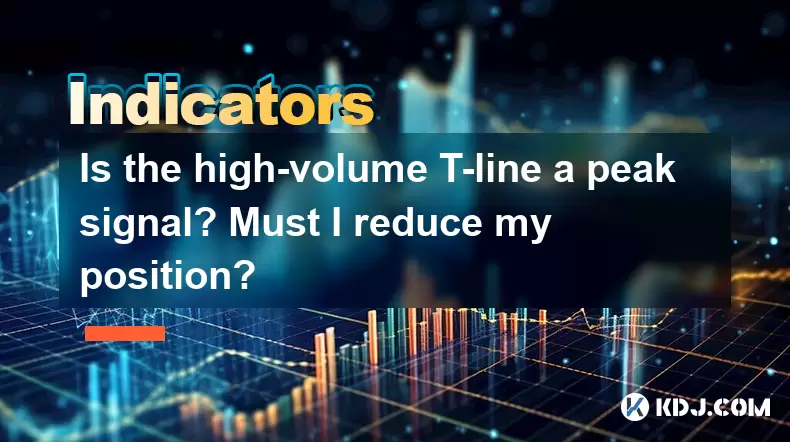
Is the high-volume T-line a peak signal? Must I reduce my position?
Jun 17,2025 at 06:07pm
Understanding the T-Line Pattern in Cryptocurrency TradingIn cryptocurrency trading, technical patterns are frequently used by traders to anticipate price movements. One such pattern is the T-line, which appears on candlestick charts and is characterized by a long upper or lower shadow with little or no body. A high-volume T-line occurs when this patter...
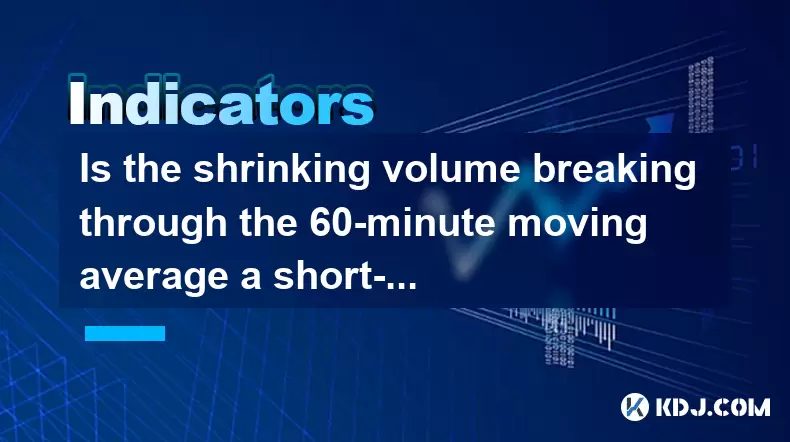
Is the shrinking volume breaking through the 60-minute moving average a short-term weakness? Should I run?
Jun 17,2025 at 06:21pm
Understanding the 60-Minute Moving Average in Cryptocurrency TradingIn cryptocurrency trading, the 60-minute moving average is a popular technical indicator used by traders to assess short-term trends. This metric calculates the average price of an asset over the last 60 minutes and updates with each passing minute. Traders often use it to identify pote...

Should I stop loss immediately when the 60-minute level has continuous top divergence?
Jun 17,2025 at 05:28pm
Understanding Top Divergence in the 60-Minute ChartIn cryptocurrency trading, top divergence refers to a technical signal where the price of an asset makes higher highs while the indicator (often RSI or MACD) makes lower lows. This is commonly interpreted as a sign of weakening momentum and potential reversal. When this occurs on the 60-minute chart, it...

Does the opening of the Bollinger band horn indicate the arrival of a big market?
Jun 17,2025 at 06:28pm
Understanding the Bollinger Bands and Their StructureBollinger Bands are a widely used technical analysis tool in the cryptocurrency market, developed by John Bollinger. They consist of three lines: a simple moving average (SMA), typically set at 20 periods, and two standard deviation bands above and below this SMA. These bands dynamically expand and co...

Is the high opening the next day after the low-level limit down the end of the wash?
Jun 17,2025 at 05:57pm
Understanding the Concept of a Limit Down and Its ImplicationsIn the world of cryptocurrency trading, a limit down refers to a situation where the price of a digital asset drops sharply, reaching its maximum allowable decline within a specific time frame. This mechanism is often seen on exchanges that implement daily price limits to prevent excessive vo...

Is it a short-term adjustment if it falls below the 3-day line but is still on the 10-day line?
Jun 17,2025 at 04:07pm
Understanding the 3-Day and 10-Day Moving AveragesIn cryptocurrency trading, moving averages are essential tools for gauging trend strength and potential reversals. The 3-day moving average is a short-term indicator that reflects recent price action with minimal lag, making it highly sensitive to sudden market shifts. In contrast, the 10-day moving aver...

Is the high-volume T-line a peak signal? Must I reduce my position?
Jun 17,2025 at 06:07pm
Understanding the T-Line Pattern in Cryptocurrency TradingIn cryptocurrency trading, technical patterns are frequently used by traders to anticipate price movements. One such pattern is the T-line, which appears on candlestick charts and is characterized by a long upper or lower shadow with little or no body. A high-volume T-line occurs when this patter...

Is the shrinking volume breaking through the 60-minute moving average a short-term weakness? Should I run?
Jun 17,2025 at 06:21pm
Understanding the 60-Minute Moving Average in Cryptocurrency TradingIn cryptocurrency trading, the 60-minute moving average is a popular technical indicator used by traders to assess short-term trends. This metric calculates the average price of an asset over the last 60 minutes and updates with each passing minute. Traders often use it to identify pote...
See all articles

























































































